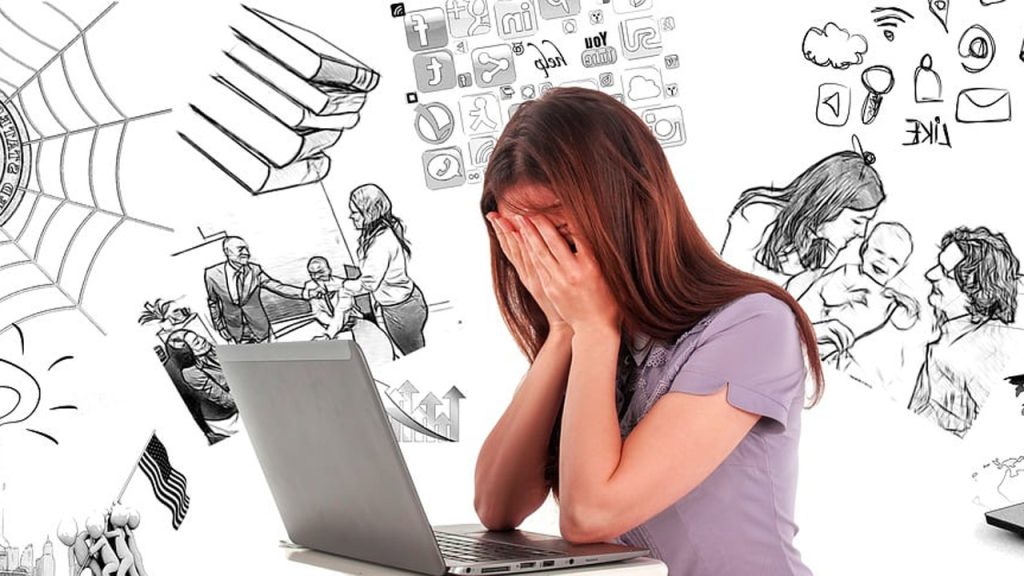In today’s fast-paced and interconnected world, technology has become an integral part of our daily lives, transforming the way we communicate, work, and even learn. While the advancements in technology have undoubtedly brought about numerous benefits to education, we cannot overlook its negative impact. This article delves into the detrimental effects of technology on education and explores how it hampers traditional learning methods.

Photo by geralt, Pixabay
Decreased attention span and increased distraction
One of the primary concerns is the prevalence of distractions that accompany technology in the classroom. With smartphones, tablets, and laptops at their fingertips, students are easily lured away from focusing on their studies. Social media, online games, and other digital temptations can divert their attention, resulting in decreased productivity and overall academic performance.
The constant notifications and alerts from various applications keep students in a state of perpetual distraction. The need to check messages, updates, and likes becomes more important than focusing on the lesson at hand. This decreased attention span can lead to limited absorption of information and reduced retention of knowledge.
Additionally, multitasking becomes a common phenomenon when technology is present in the classroom. Students may attempt to simultaneously listen to the teacher, browse the internet, and engage in online conversations. This multitasking not only hampers their ability to concentrate but also affects their ability to comprehend and process information effectively.
The increased distractions caused by technology can have a detrimental impact on students’ ability to engage with the learning material and hinder their overall educational experience.
Negative effects on social skills and interpersonal relationships
Another aspect of technology’s negative impact on education is the negative effect it has on students’ social skills and interpersonal relationships. With the widespread use of digital communication platforms, students may rely more on virtual interactions rather than face-to-face interactions.
The lack of in-person communication can lead to a decline in essential social skills, such as effective verbal and non-verbal communication, active listening, and conflict resolution. Students may find it challenging to develop empathy and emotional intelligence when they primarily communicate through screens rather than engaging in real-life interactions.
The constant exposure to social media and online platforms can lead to feelings of loneliness, isolation, and social comparison among students. The pressure to conform to online trends and portray a certain image can be overwhelming and detrimental to their self-esteem and mental well-being.
By neglecting the development of strong interpersonal relationships, students miss out on essential life skills that are crucial for personal and professional success. It is important to strike a balance between the use of technology and fostering meaningful social interactions to ensure students’ holistic development.
Limited physical activity and health issues
The increasing use of technology in education has led to a sedentary lifestyle among students, contributing to various health issues. With the advent of online learning platforms and digital resources, students spend extended periods sitting in front of screens, resulting in a lack of physical activity.
Physical activity plays a crucial role in maintaining overall health and well-being. It not only helps in improving cardiovascular fitness but also enhances cognitive function and concentration. The absence of physical activity can lead to a decline in students’ physical health, including obesity, weakened muscles, and poor posture.
Prolonged screen time has been linked to various health issues, such as eye strain, headaches, and sleep disturbances. The blue light emitted by screens can disrupt the production of melatonin, a hormone essential for regulating sleep cycles, leading to difficulties in falling asleep and poor quality of sleep.
To combat these health issues, it is important to incorporate physical activity breaks and promote healthy screen habits among students. Encouraging outdoor activities, physical education classes, and implementing screen time limits can help mitigate the negative effects of technology on students’ health.
Dependence on technology and reduced critical thinking skills
Technology can create a sense of dependency, hindering critical thinking and problem-solving skills. The instant availability of information through search engines eliminates the need for students to engage in deep analysis and critical thought processes. As a result, they may become passive learners and lack the ability to think critically and independently.
Technology often provides students with predetermined solutions to problems, leaving little room for creativity and innovation. The reliance on technology solutions can hinder the development of essential problem-solving skills, as students may become accustomed to seeking immediate answers rather than exploring different possibilities and developing their own solutions.
The abundance of information and resources available online can lead to a lack of information filtering skills. Students may struggle to distinguish reliable sources from unreliable ones, leading to the dissemination of inaccurate or misleading information. This lack of critical evaluation can negatively impact students’ ability to conduct research and form well-rounded perspectives.
To address this issue, educators should emphasize the importance of critical thinking, problem-solving, and information literacy skills. Encouraging students to question, analyze, and evaluate information independently can help them develop the necessary skills to navigate the digital landscape effectively.
Information overload and lack of information filtering
The digital age has brought about an overwhelming amount of information readily available at our fingertips. While this abundance of information can be beneficial, it can also lead to information overload and difficulties in filtering relevant and accurate information.
With the ease of access to information, students may find it challenging to navigate through the vast sea of data and identify credible and reliable sources. The lack of information filtering skills can result in the inclusion of irrelevant or inaccurate information in academic assignments and projects, leading to a decline in the quality of work.
The constant exposure to a barrage of information can lead to cognitive overload, making it difficult for students to process and retain knowledge effectively. The continuous influx of information can be overwhelming and hinder students’ ability to focus on specific topics, leading to a shallow understanding of the subject matter.
To tackle information overload, educators should teach students effective research and information evaluation skills. Teaching students how to critically assess sources, identify bias, and differentiate between primary and secondary sources can empower them to filter information effectively and enhance the quality of their work.
Cyberbullying and online harassment
The rise of technology in education has also brought with it the unfortunate increase in cyberbullying and online harassment. The anonymity and distance provided by online platforms can embolden individuals to engage in harmful behavior, targeting students through various digital channels.
Cyberbullying can have severe consequences on students’ mental health, leading to increased levels of stress, anxiety, and depression. The constant fear of being targeted online can negatively impact students’ self-esteem and overall well-being, ultimately affecting their academic performance and engagement.
Schools and educational institutions must take proactive measures to address cyberbullying and online harassment. Implementing strict anti-bullying policies, fostering a safe and inclusive digital environment, and educating students about responsible online behavior are crucial steps in combating this issue. Encouraging open communication and providing support systems for victims of cyberbullying can help create a safe and supportive learning environment.
Privacy and security concerns
As technology becomes more integrated into education, concerns regarding privacy and data security arise. The collection and storage of personal data, including students’ academic records, personal information, and online activities, can pose significant privacy risks if not adequately protected.
Data breaches and unauthorized access to sensitive information can result in severe consequences, such as identity theft, fraud, and the compromise of personal and financial security. Students and their families have the right to know how their data is being collected, used, and protected, and it is the responsibility of educational institutions to ensure the utmost security and privacy measures are in place.
Educational institutions must adhere to strict data protection laws and regulations, implement robust security measures, and educate students about responsible online behavior and the importance of protecting their personal information. By prioritizing privacy and security, educational institutions can mitigate potential risks and safeguard students’ sensitive data.
Inequality and the digital divide
While technology has the potential to bridge gaps and provide equal opportunities for all students, it also highlights the existing inequalities in access to resources and digital literacy skills. The digital divide refers to the gap between individuals who have access to technology and those who do not, resulting in disparities in educational opportunities and outcomes.
Students from disadvantaged backgrounds may lack access to reliable internet connections, computers, and other necessary technological tools. This lack of access hampers their ability to fully engage in online learning platforms, access educational resources, and develop essential digital literacy skills.
To address this issue, it is essential to promote digital inclusivity and bridge the digital divide. Providing equal access to technology and internet connectivity, offering digital literacy programs, and partnering with organizations to provide resources to underserved communities can help ensure that all students have an equal opportunity to benefit from technology in education.
Conclusion and recommendations for a balanced approach to technology in education
While technology undoubtedly has its merits, it is essential to recognize and address its negative impact on education. By understanding these drawbacks, we can develop strategies to minimize its adverse effects and create a balanced learning environment that harnesses technology for the betterment of education.
To achieve this balance, educators should:
- Establish clear guidelines and boundaries for technology use in the classroom, emphasizing its purpose as a tool for learning rather than a source of distraction.
- Incorporate active learning strategies that encourage student engagement and collaboration, ensuring that technology is used as a means to enhance and enrich the learning experience.
- Promote media literacy skills to enable students to critically analyze and evaluate digital content, empowering them to navigate the digital landscape responsibly.
- Foster a supportive and inclusive digital environment that addresses cyberbullying and online harassment, ensuring the safety and well-being of all students.
- Bridge the digital divide by advocating for equal access to technology and providing necessary resources and support to underserved communities.
By adopting a balanced approach to technology in education, we can harness its potential while mitigating its negative impact, ultimately creating a conducive environment for students to thrive and succeed. It is through thoughtful integration and careful consideration that we can maximize the benefits of technology in education while minimizing its drawbacks.




